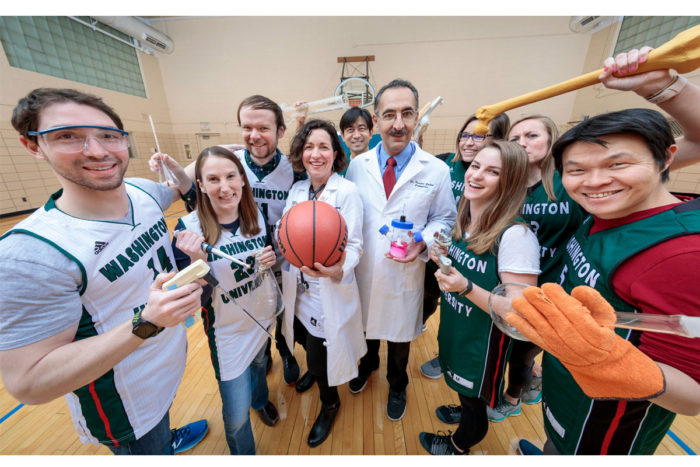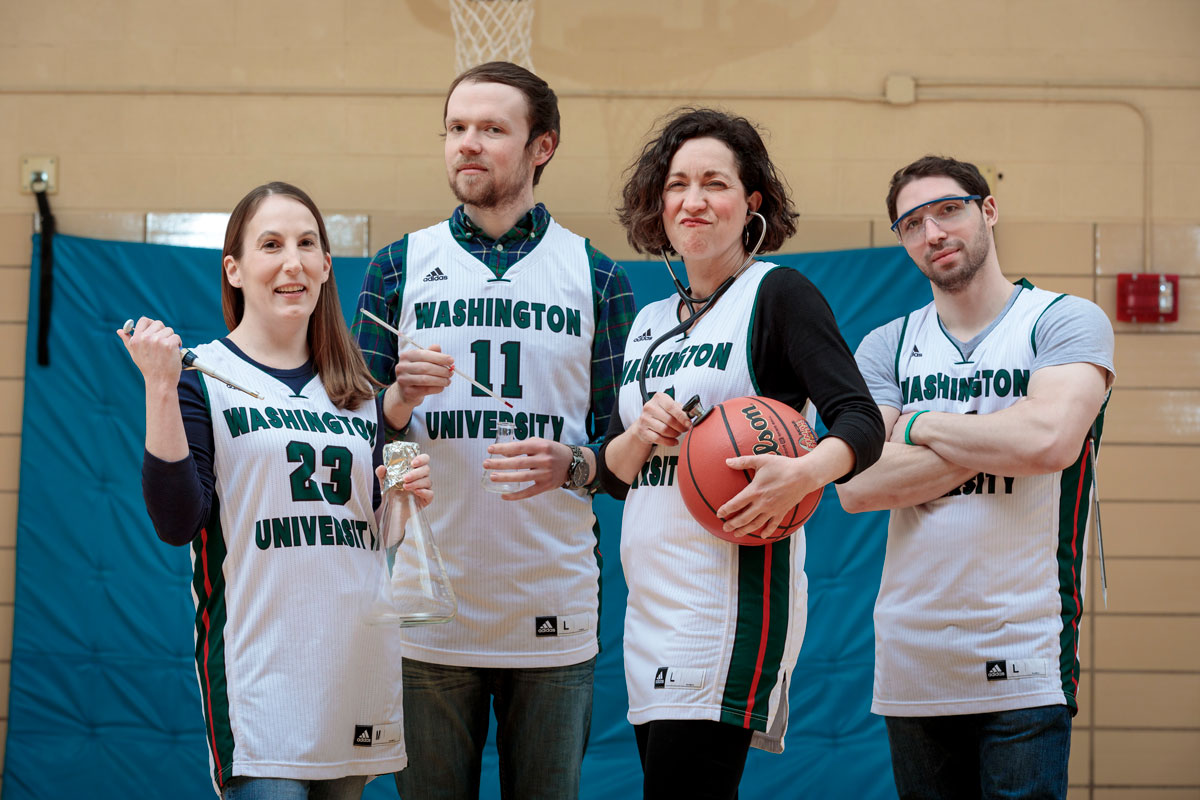Two medical school teams competing in national scientific ‘March Madness’
Voting for best biomedical innovations of 2017 has begun
 Matt Miller
Matt MillerWashington University School of Medicine has two teams that were chosen to compete in STAT Madness 2018, a national, playoff-style competition in search of the top biomedical innovations of 2017. Shown are members of WashU's two teams: (from left) Michael Ross; Alison Esser, PhD; Gregg Fox; team leader Katherine N. Weilbaecher, MD; Yunrak Choi; team leader Farshid Guilak, PhD; Kelsey Collins, PhD; Lara Pferdehirt; Ali Ross; and Chia-Lung Wu, PhD.
Two research teams at Washington University School of Medicine have been chosen to compete in the March Madness of science and medicine — STAT Madness, a playoff-style competition that pits the nation’s top research institutions against each other in search of the best biomedical innovations of 2017. The tournament is hosted by STAT, an online publication focused on medicine, health and scientific discovery.
The 64-team bracket was revealed at 12:01 a.m. ET Monday. One WashU team is led by Farshid Guilak, PhD, a professor of orthopedic surgery, who will duke it out with a team led by researchers at Cold Spring Harbor Laboratory and the University of Massachusetts. The second WashU team — co-led by Katherine N. Weilbaecher, MD, the Oliver M. Langenberg Distinguished Professor of the Science and Practice of Medicine, and Gregory M. Lanza, MD, PhD, the James R. Hornsby Family Professor of Biomedical Sciences — will face a team led by researchers at Yale University and Yale School of Medicine.
Much like the NCAA Tournament (minus the torn ACLs, pricey tickets and heated allegations of questionable calls), the biomedical tournament starts with 64 teams. In STAT Madness, however, the winner of each round is determined by popular vote.
Online voting opened at 12:01 a.m. Monday and will continue through 11:59 p.m. ET Thursday, March 1. There will be voting with each subsequent round, all the way to the national title. (In case you’re wondering, YES, you can vote more than once in each round!)
 Matt Miller
Matt MillerLanza, also a professor of biomedical engineering, and Weilbaecher made the cut for their work developing chemo-loaded nanoparticles to target breast cancer. The strategy lets chemotherapy penetrate the protective environment of bone and minimizes toxic side effects.
In a recent study, the researchers showed that breast cancer cells that spread to bone carry molecules on their surface that are a bit like Velcro, helping tumor cells stick to the bone. They designed a nanoparticle that combines the bone-adhesion molecules with a form of the cancer drug docetaxel, which is used to treat breast cancer as well as other tumors. The adhesive molecules allow the nanoparticle to penetrate the otherwise protective environment of the bone matrix in a way that, in essence, mimics the spreading of the tumor cells themselves. The result is a delivery method that keeps the chemotherapy drug contained in the nanoparticle until the adhesion molecules make contact with the tumor cell, fusing the nanoparticle with the cell surface and releasing the drug directly into the cancer cell.
In mice implanted with human breast cancer and exposed to circulating cancer cells likely to take up residence in bone, the researchers showed the treatment kills tumor cells and reduces bone destruction while sparing healthy cells from side effects.
 Matt Miller
Matt MillerGuilak’s lab earned a spot in the bracket after his team rewired stem cells to produce an anti-inflammatory arthritis drug when the cells encounter inflammation. The eventual goal is to create a vaccine that targets inflammation in joints.
The researchers initially worked with skin cells taken from the tails of mice and converted those cells into stem cells. Then, using the gene-editing tool CRISPR in cells grown in culture, they removed a key gene in the inflammatory process and replaced it with a gene that releases a biologic drug that combats inflammation.
“Our goal is to package the rewired stem cells as a vaccine for arthritis, which would deliver an anti-inflammatory drug to an arthritic joint, but only when it is needed,” Guilak explained. “To do this, we needed to create a ‘smart’ cell.”
To read more about the competition and sign up for STAT Madness alerts, see STAT’s writeup on the second annual battle.
And now … go vote! Let’s go, WashU!






